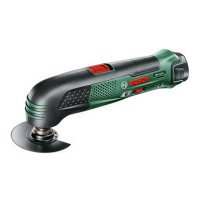16 | English
1 609 92A 0SE | (30.10.14) Bosch Power Tools
Technical file (2006/42/EC) at:
Robert Bosch GmbH, PT/ETM9,
70764 Leinfelden-Echterdingen, GERMANY
Robert Bosch GmbH, Power Tools Division
70764 Leinfelden-Echterdingen, GERMANY
Leinfelden, 15.10.2014
Assembly
Battery Charging
Use only the battery chargers listed on the accessories
page. Only these battery chargers are matched to the lith-
ium-ion battery of your power tool.
Note: The battery supplied is partially charged. To ensure full
capacity of the battery, completely charge the battery in the
battery charger before using your power tool for the first time.
The lithium-ion battery can be charged at any time without re-
ducing its service life. Interrupting the charging procedure
does not damage the battery.
Removing the battery
To remove the battery 2, press the unlocking buttons 1 and
pull the battery out of the machine to the rear. Do not exert
any force.
Battery Charge-control Indication
When the power tool is switched on, the battery charge-con-
trol indicator 4 signals the still available battery capacity or an
overload.
When the battery charge-control indicator 4 flashes red, the
machine is subject to overload. Please observe the informa-
tion in section “Temperature-dependent Overload Protec-
tion”, page 19.
Changing the Tool
Before any work on the machine itself (e. g. mainte-
nance, tool change, etc.) as well as during transport
and storage, remove the battery from the power tool.
There is danger of injury when unintentionally actuating
the On/Off switch.
Wear protective gloves when changing application
tools/accessories. Contact with the application tool/ac-
cessory can lead to injuries.
Selecting the Application Tool/Accessory
The following table shows examples for application tools. Further application tools can be found in the extensive Bosch acces-
sories program.
Henk Becker
Executive Vice President
Engineering
Helmut Heinzelmann
Head of Product Certification
PT/ETM9
Indication Capacity
Continuous lighting, green >70 %
Continuous lighting, yellow 30–70 %
Continuous lighting, red <30 %
Accessory Material Application
BIM segment saw
blade
Wooden materials, plas-
tic, non-ferrous metals
Separating and plunge cuts; also for sawing close to edges,
in corners and hard to reach areas;
example: shortening already installed bottom rails or door
hinges, plunge cuts for adjusting floor panels
Base plate for sand-
ing, series Delta
93 mm
Depends on sanding sheet Sanding surfaces close to edges, in corners or hard to reach
areas;
depending on the sanding sheet for, e.g., sanding wood,
paint, varnish, stone
HCS plunge cut saw
blade, wood
Wooden materials, soft
plastics
Separating and deep plunge cuts; also for sawing close to
edges, in corners and hard to reach areas;
example: narrow plunge cut in solid wood for installing a
ventilation grid
HCS plunge cut saw
blades, wood
Wooden materials, soft
plastics
Smaller separating and plunge cuts;
example: cut-outs in furniture for cable connections
BIM plunge cut saw
blades, metal
Metal (e. g. unhardened
nails, screws, smaller pro-
files), non-ferrous metals
Smaller separating and plunge cuts;
example: shortening narrow profiles, cutting fastening
elements such as staples
OBJ_BUCH-1170-005.book Page 16 Thursday, October 30, 2014 8:12 AM

